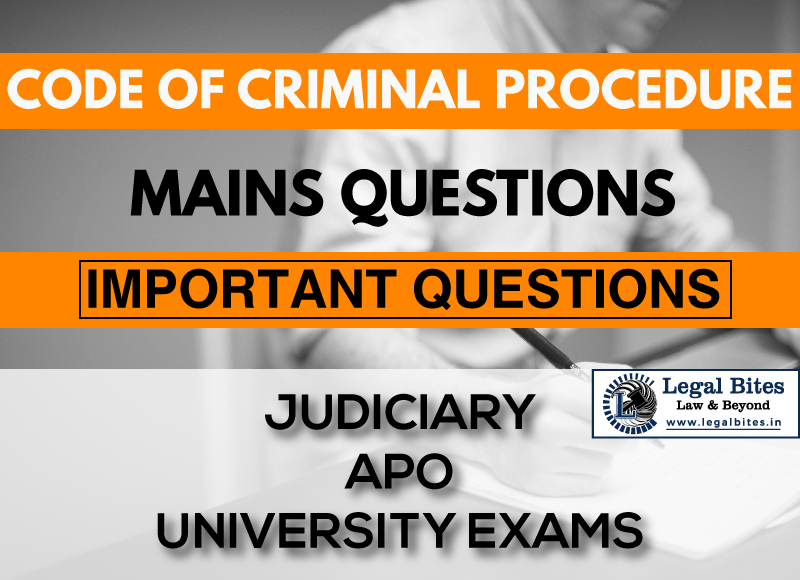What do you mean by Multiple F.I.R.? What is the evidentiary value of it?
Find the answer to the mains question only on Legal Bites.

Question: What do you mean by Multiple F.I.R.? What is the evidentiary value of it?Find the answer to the mains question only on Legal Bites. [What do you mean by Multiple F.I.R.? What is the evidentiary value of it?]AnswerThe Second FIR is a consecutive FIR filed after the information on the commission of a cognizable offence has also been given to the police officer under Section 154 of CrPC. It means that the second FIR would relate to the initial FIR in regards to the same offence that...
Question: What do you mean by Multiple F.I.R.? What is the evidentiary value of it?
Find the answer to the mains question only on Legal Bites. [What do you mean by Multiple F.I.R.? What is the evidentiary value of it?]
Answer
The Second FIR is a consecutive FIR filed after the information on the commission of a cognizable offence has also been given to the police officer under Section 154 of CrPC. It means that the second FIR would relate to the initial FIR in regards to the same offence that has been committed or the same accused persons who have committed it. There could be various possibilities here and that is why the law has to be very specific in permitting the registration of the second FIR.
The possibility of filing a second FIR came up in Ram Lal Narang v. State of Delhi, 1979 AIR 1791. In this case, the first FIR was revealed to be a part of the larger conspiracy that was only disclosed in the second FIR. The issue was whether the two conspiracies were identical. The court held that even though some of the conspirators were the same in both the two events, the objectives were different. It cannot be said that both FIRs refer to the commission of the same offence.
When second FIR cannot be filed?
The impermissibility of registering the second FIR is to protect the fundamental right of an accused against double jeopardy, to maintain the rule of fair investigation and to disallow the police to abuse their investigative powers under CrPC. These three-fold safeguards prevent registration of the second FIR as held in Anju Chaudhary v. State of UP, Arising out of SLP (Crl) No.9475 of 2008.
Test of Sameness
The legality of the second FIR was extensively discussed in T.T. Antony v. State of Kerala, Appeal (crl.) 689 of 2001. The court established the test of sameness which means that unless in both the two cases, where the first and second FIR are registered respectively, the FIRs appear to be substantially different from each other such as in facts and circumstances, the second FIR cannot be filed. This means that the facts and circumstances giving rise to the two FIRs must be different, the offence committed in the two must be different, or the person accused of committing the offence is different. Only then, the second FIR is permissible.
The court further observed, that the scheme of provisions starting from Section 154 of CrPC to Section 173 CrPC, that is from the starting to the ending of an investigation, relates to the earliest or the first information given in the commission of a cognizable offence. This is what satisfies the requirement of Section 154 CrPC.
Thus, there is no scope to start any fresh investigation on receipt of every subsequent information received in respect of the same cognizable offence.
Test of Consequence
Where the offence registered under the second F.I.R. occurs as a consequence of the offence alleged to have occurred in the first FIR the ‘test of consequence’ is to be applied. In the case of C. Muniappan v. State of Tamil Nadu, Criminal Appeal Nos. 127-130 of 2008. The court held that the offences alleged to have occurred in both the FIRs are the same and thus, the second FIR will not be permissible. This test of consequence has been reiterated by the court in Amitbhai Anilchandra Shah v. CBI, Writ Petition (Criminal) Nos. 149 of 2012 and 5 of 2013.
The test of consequence is also to be applied in cases where the offence disclosed in the first FIR is not the same as the offence disclosed in the second FIR. In this case, a second FIR is permissible. This may also include a situation where the second FIR is lodged by different persons and in different police stations. In Chirag M. Pathak v. Dollyben Kantilal Patel, (2018) 1 SCC 330, this issue came up when six FIRs were lodged based on identical facts but in different police stations by six different cooperative societies. The Supreme Court accepted all the FIRs based on the reasoning that they are lodged by different persons and the totality of factual allegations constitutes the commission of different offences. Hence, the FIRs were not overlapping.
Important Mains/Long Questions for Judiciary, APO & University Exams
- CRPC Mains Questions Series Part I: Important Questions
- CRPC Mains Questions Series Part II: Important Questions
- CRPC Mains Questions Series Part III: Important Questions
- CRPC Mains Questions Series Part IV: Important Questions
- CRPC Mains Questions Series Part V: Important Questions
- CRPC Mains Questions Series Part VI: Important Questions
- CRPC Mains Questions Series Part VII: Important Questions
- CRPC Mains Questions Series Part VIII: Important Questions
- CRPC Mains Questions Series Part IX: Important Questions
- CRPC Mains Questions Series Part X: Important Questions
- CRPC Mains Questions Series Part XI: Important Questions

Mayank Shekhar
Mayank is an alumnus of the prestigious Faculty of Law, Delhi University. Under his leadership, Legal Bites has been researching and developing resources through blogging, educational resources, competitions, and seminars.
